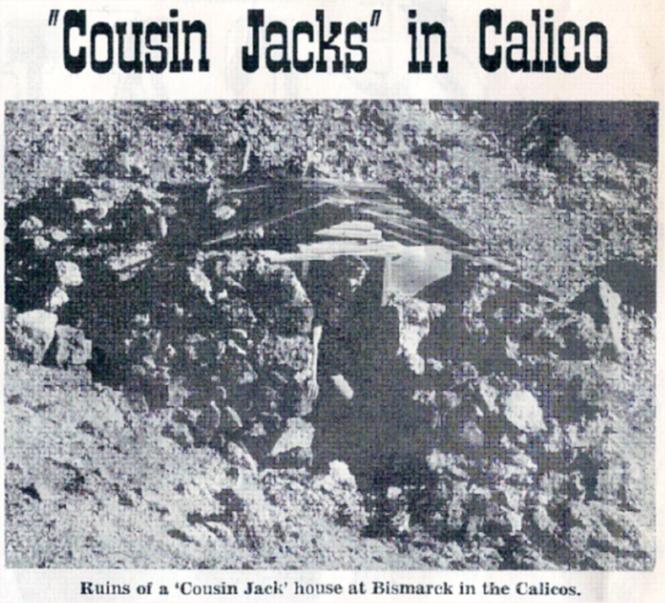By Herman F. Mellen

Most of the small piled rock and semi-dugout dwellings near the mines at Calico were built by Cornish miners, known as “Cousin Jacks,” possibly because about every third person among them was named John and called Jack and because so many of them seemed to be related. They had a great feeling for ties of blood, and when they became prosperous, they would send for their relatives.
I first became acquainted with them at the Garfield mine in Odessa canyon in 1884. About 50 per cent of the working force there, including the mine foreman, was Cornish. They spoke a patois all their own; a mixture of English, Welsh and probably Gaelic, with a few words brought down from the ancient Picts. Their sentence structure was unique which, with their peculiar accent and mode of speaking made it hard for one not acquainted to I understand them. I remember once there was an Englishman in camp, from a county just north of Cornwall and a Cousin Jack criticized his speech, saying, “Why don’t ‘e speaken English like I do?” The Englishman retorted: “You don’t speak English-you gobble!”
And they did gobble, speaking rapidly in a deep guttural. They had many peculiarities of tongue. “Take” was always “taken.” An ore car was always a “wagon” and they never pushed, but would “go forth” with it. They used the third person where we ordinarily use the second, and most of their sentences ended with “you.” “How’s the mother, you?”
I soon caught onto their language, and as they were almost without exception kindly and companionable I men, I enjoyed working with them and learned much from them, both of the trade of mining and their history and beliefs. For example, there were the Tommy Knockers – if that is the way it is spelled. These were the little people who populated the mines. They were in the walls and everywhere, according to the Cousin Jacks. You know, in a mine tunnel more than anywhere else there are mysterious sounds – the natural creaking of timbers and settling of rocks – and of course these were the Tommy Knockers, warning of impending disaster. It was just too bad if you could not understand what they were trying to say, for they might be warning you.
I remember only one characteristic food of the Cousin Jacks – cakes and puddings colored with saffron. I suppose it was all right, but that orange-yellow looked pretty deadly to me. The pudding was made of cut up dried or canned fruit – any kind they happened to have – with just enough flour to hold it together and saffron. This was put in a cloth or sack and boiled.
The Cornishmen did not combine to any extent the calling of miner with that of prospector, as did most other nationalities. They were the best miners as a whole that the world could boast, having followed the trade, father and son, for centuries. The big Cornishman Jack Pascoe was a fine example. Jack was well over six feet in height and every inch a miner, and a great worker. At one time he was hired for a short time to substitute for one of three partners who were doing 400 feet of tunnel in the King mine by contract. Putting in every third shift in the tunnel, Jack raised its roof by a foot and a half every shift he worked, in order to accommodate his great height. When the annoyed contractors protested, his reply was:
“Dammee, old son, you! Have to maken place for my feet!”
The wavy roof in this tunnel became known as Jack Pascoe’s mark.
When I visited it last in 1941, I could tell exactly the number of shifts Jack had worked.